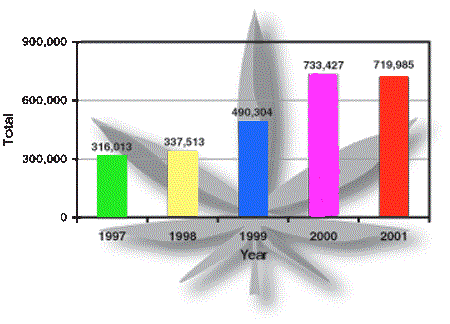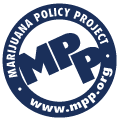|
Marijuana is the most readily available and widely used illicit drug in the United States. The prevalence of the drug throughout the country has contributed to both an acceptance of its use among some adults and adolescents and a perception that marijuana use is not harmful. The consequences are telling. Admissions to publicly funded treatment facilities for marijuana/hashish use increased from 142,633 to 223,597 between 1994 and 1999. Of these admissions in 1999, more than half (57%) first used the drug by the age of 14, and 92 percent first used by the age of 18. Emergency department mentions of marijuana have increased steadily as well, most notably among patients aged 12-17, for whom mentions increased more than 140 percent between 1994 and 2000.
Traffickers in foreign source areas and in the United States supply users with large amounts of marijuana of varying potency. Lower potency marijuana, much of which is produced in Mexico, is endemic–even in major domestic cultivation areas, large amounts of marijuana produced in Mexico are available. The prevalence of higher potency marijuana is increasing, however, as evidenced in samples submitted to the University of Mississippi’s Potency Monitoring Project for testing. Marijuana samples testing at or greater than 9 percent THC accounted for 2.97 percent of samples submitted in 1992, 9.13 percent of samples submitted in 1997, and 14.66 percent of samples submitted in 2001.
The large user population in the United States equates to steady profits, and drug trafficking organizations, criminal groups, and gangs involved in trafficking drugs such as cocaine or heroin are trafficking marijuana as well to help finance their drug operations. Another likely factor behind some traffickers’ involvement is the belief that the penalties associated with the trafficking of marijuana are less than those for other illicit drugs.
Marijuana-related violence, when it occurs, typically is associated with cannabis cultivation, although there are reports of violence associated with transportation and distribution of the drug. Also, the current user population is exposed to more potent marijuana than in previous years, and strong or high doses may result in rapidly fluctuating emotions, disorientation, or hallucinations, thereby exposing users and those around them to potential harm. Marijuana used in combination with, or as a delivery medium for, other drugs further increases the risk.
The hazards of marijuana use do not seem to have an effect on most users’ attitudes and perceptions concerning the drug. Common perceptions among users and the general population are that marijuana is not as harmful as other drugs and that use carries little social stigma. The perception that marijuana is not as harmful or disruptive as other illicit substances may influence investigative priorities, too, particularly among agencies with limited resources or those dealing with more socially disruptive criminal activity such as gang violence. Indeed, most state and local law enforcement agencies that responded to the National Drug Threat Survey 2001 identified marijuana availability and use as high, while identifying the threat of marijuana to public safety and health as stable at varying levels. Law enforcement reporting reveals, however, that marijuana seizures occur not only during investigations targeting that drug but also during those that target other drugs or other criminal activity.
To Top To Contents
Marijuana is the most available illicit drug throughout the United States. The indoor and outdoor cultivation of cannabis in every region of the country, as well as the presence of marijuana smuggled into the United States from foreign sources, contributes to the pervasiveness of the drug. Although the breadth of its availability is clear, no exact estimates of the amount of marijuana available in the United States have been determined. The only concrete data that can provide insight, albeit limited, into marijuana availability are seizure statistics. Seizures of marijuana reported in the Federal-wide Drug Seizure System (FDSS) accounted for 1,075 metric tons in 1999, 1,235 in 2000, and 1,213 in 2001. A large percentage of the seized marijuana was from foreign source areas. Most of the foreign-source marijuana found in the United States is produced in Mexico; other foreign sources include Colombia, Canada, and Jamaica.
Despite appearances that the threat of marijuana is overshadowed by concern with other illicit drugs, data show that law enforcement and judicial system efforts to reduce marijuana trafficking through investigations and indictments are continuing. The number of federal sentences for marijuana increased between fiscal year (FY) 2000 (7,301) and FY2001 (7,991). Organized Crime Drug Enforcement Task Force (OCDETF) indictments on marijuana-related charges dropped from 774 in FY2000 to 711 in FY2001, but at 18.8 and 17.4 percent, respectively, accounted for a similar percentage of all OCDETF indictments in those fiscal years.
Law enforcement reporting from every region identifies marijuana produced in the United States and Mexico as the most prevalent types available. Other marijuana types are available to varying degrees depending on the area of the country. Sources in Colombia and Jamaica supply marijuana more in the eastern United States, specifically in the Southeast and New York/New Jersey regions. Nonetheless, marijuana supplied by both Colombian and Jamaican sources has been identified in the New England and Great Lakes regions as well, and marijuana from Jamaican sources also has been identified in the Mid-Atlantic.
Law enforcement and anecdotal reporting suggests that marijuana from Canada, commonly referred to as BC Bud, is now in every region of the United States to varying degrees (see Text Box). Marijuana from Canada probably accounts for a greater proportion of available supplies in the Pacific and West Central regions than in the rest of the country, but quantities are still not as high as marijuana grown domestically or in Mexico. Marijuana produced in Thailand is available in limited quantities in areas of the western United States and in New York.
The term "BC Bud," which originally referred to the bud of the unpollinated female cannabis plant grown in British Columbia, has become synonymous with any high-grade marijuana from Canada.
|
To Top To Contents
Marijuana often is defined not by its source of origin but by its quality. Commercial-grade is typically low in potency and contains lower quality parts of the cannabis plant such as leaves, stems, and seeds. This type is typical of marijuana produced in Mexico. Sinsemilla, higher potency marijuana, contains only the leaves and the buds of unpollinated female cannabis plants, in which the primary psychoactive chemical of the cannabis plant, THC (tetrahydrocannabinol), is most concentrated. This type is typical of marijuana produced in Canada. On the surface, it may seem unlikely that a large market would exist for commercial-grade in areas in which sinsemilla is available. But traffickers use commercial-grade marijuana to augment supplies of sinsemilla by increasing the bulk–and, consequently, the profits–and to replace supplies of sinsemilla when they are depleted. Among users, too, there is always demand for a less expensive product.
Overall potency as characterized by THC content is rising, continuing overall increases through much of the previous decade and potentially exposing users to a higher risk of dependence. According to data from the Potency Monitoring Project, funded by the National Institute on Drug Abuse (NIDA), the average potency of samples of all cannabis types increased from 3.00 percent in 1991 to 5.23 percent in 2001. When broken down by type, potency generally increased from 3.09 percent to 5.01 percent for commercial-grade marijuana during the same period, but fluctuated for sinsemilla. The concentration of THC in sinsemilla averaged 10.53 percent in 1991, dipped to a low of 5.77 percent in 1993, and increased steadily to a peak of 13.38 percent in 1999 before declining to 9.10 percent in 2001.
The price of marijuana varies widely. According to the Drug Enforcement Administration (DEA), the national average price for a pound of marijuana in 2000 ranged from $100 to $6,500 for commercial-grade and from $900 to $8,000 for sinsemilla. The wide range in marijuana prices reflects variables such as potencies, quantities purchased, purchase frequencies, buyer-seller relationships, transportation costs, and proximity to sources of supply.
Most law enforcement and epidemiologic sources cite the availability of marijuana as stable at high levels, widespread, or increasing. Responses to the National Drug Threat Survey 2001 regarding availability and use appear to concur. Of 1,261 respondents, 1,048 identified marijuana availability as high, and 901 identified use as high. This pervasiveness contributes to a broad user population that normally reflects the demographics of the general population of any given area. Reporting from across the country identifies marijuana use among a wide range of age, ethnic, and economic groups. High levels of use are cited particularly among youth, however.
Also derived from cannabis, hashish is the THC-rich resinous material from the flowering tops of the female plant; potency averages 6 percent. Law enforcement reporting indicates that hashish availability is low, most likely because demand for the drug is low. Personal-use amounts are seized occasionally in the eastern and western United States and at ports of entry (POEs) along the U.S.-Canada border, and large shipments of hashish destined for Canada sometimes are seized while in transit through the United States. One domestic seizure of 10.6 metric tons destined for Montreal accounted for nearly the entire U.S. seizure total for hashish in 2000.
To Top To Contents
Estimates of the number of marijuana users in the United States suggest that demand for marijuana far exceeds that of any other illicit drug. As of 2000, more than 76 million individuals aged 12 and older had tried marijuana in their lifetime, more than 18 million had used in the past year, and nearly 11 million in the past month, according to the National Household Survey on Drug Abuse (NHSDA). Furthermore, 2000 NHSDA data indicate that on an average day, 5,556 individuals–of whom 3,814 are aged 12 to 17–try marijuana for the first time.
National-level drug prevalence indicators show that while the rates of marijuana use are higher today than in the early 1990s when marijuana use waned, they have stabilized or decreased over the last few years, especially among young users. According to 2001 Monitoring the Future (MTF) data, rates of past year use are stable or declining. In 2001, 15.4 percent of eighth graders used marijuana in the past year, continuing a gradual decline since peaking at 18.3 percent in 1996. The rate of past year use among tenth and twelfth graders in 2001 was 32.7 and 37.0 percent, respectively, holding relatively steady since peaking in 1997 at 34.8 and 38.5 percent.
Similar to the MTF figures, data from the Parents’ Resource Institute on Drug Education (PRIDE) show overall declines in past year marijuana use since it peaked in the 1996–1997 school year for junior high (14.7%) and senior high students (35.8%) as well as for twelfth graders (39.4%). Indeed, decreases in past year use between the 2000-2001 and 2001-2002 school years were significant for junior high students (9.3 to 8.3%), senior high students (32.3 to 29.4%), and twelfth graders (39.0 to 35.7%).
One factor in the decline in adolescent use is a change in youths’ attitudes toward marijuana. According to the Partnership Attitude Tracking Study (PATS), significantly more teens in 2000 perceived specific risks related to marijuana use than did in 1997, and significantly fewer teens in 2000 perceived marijuana as prevalent or difficult to reject as did in 1997. Interestingly, the MTF Study, which indicates some increase in personal disapproval of marijuana use since the mid-1990s among eighth graders only, suggests youths’ attitudes shift with age–that the lower the grade level, the higher the rate of disapproval. For example, eighth graders in 1997 disapproved of trying marijuana once or twice at the rate of 67.6 percent; as tenth graders in 1999, their disapproval rate dropped to 56.2 percent; and as twelfth graders in 2001, their disapproval rate was just 49.1 percent. This shift in attitude is thought to contribute to the higher rates of use normally seen at higher grade levels.
To Top To Contents
National-level indicators that gauge the consequences of drug use, such as the Treatment Episode Data Set (TEDS) and Drug Abuse Warning Network (DAWN), seemingly contradict the stable or declining use rates shown in the prevalence indicators. Underlying factors such as drug use patterns and treatment referrals may contribute to that interpretation, however. The use of higher potency marijuana–alone or in combination with other substances–likely affects the number of treatment admissions or emergency department visits. Also, a shift toward stricter enforcement of drug offenses or, conversely, toward alternatives to incarceration may affect treatment admissions through increased criminal justice referrals.
In 1999 the typical admission for marijuana/hashish use to publicly funded treatment facilities, as reported in TEDS data, was male (77%), Caucasian (58%), and under 20 years of age (47%). As mentioned previously, the number of publicly funded treatment admissions for marijuana/hashish use rose steadily between 1994 (142,633) and 1999 (223,597). The growing availability and use of higher potency marijuana may be adding to the rise in treatment admissions, as are combination use of marijuana with other substances and criminal justice referrals. In 1999, more than half (57%) of treatment admissions for marijuana/hashish reported secondary abuse of alcohol, and more than half (57%) were criminal justice referrals.
A possible factor behind the large percentages of criminal justice referrals reported in 1999 is the proliferation of drug courts established since the early 1990s, which integrate alcohol and drug treatment services with justice system case processing. Another factor may be the shift toward marijuana use during the 1990s among those in the criminal justice system. For example, Arrestee Drug Abuse Monitoring Program (ADAM) data indicate that by 1998 marijuana had replaced cocaine as the most prevalent drug used by male arrestees at a majority of ADAM sites. The median male adult arrestee positive rate for marijuana was 39 percent in both 1998 and 1999; this rate increased slightly to 40 percent in 2000.
DAWN emergency department (ED) data suggest a sharp escalation in the number of ED mentions for marijuana/hashish from 1990 (15,706) through 2000 (96,426). The largest increases over the decade were in the 35 and older (1,209%) and 12 to 17 (622%) age groups. Nonetheless, a comparison of data from 1998 through 2000 shows that total ED mentions have been statistically unchanged from year to year and that between 1999 and 2000, the number of mentions remained stable for all age groups. In 1999 marijuana/hashish ranked as the seventh most reported drug by DAWN medical examiners (ME), accounting for less than 6 percent of episodes. But the causes of death for most ME mentions were use of marijuana/hashish and some external physical event (47%), use of marijuana/hashish with multiple drugs (28%), and use of marijuana/hashish and a physiological condition (19%)–not use of marijuana alone. For both DAWN ED and ME mentions, marijuana/hashish usually was mentioned in combination with other drugs, most often with alcohol, cocaine, and heroin.
Marijuana is often smoked in the form of loosely rolled joints or hollowed-out commercial cigars called blunts that are easily laced with a number of adulterants or other illicit drugs–with the user’s knowledge or not–that can substantially alter effects and toxicity. For example, reporting from some areas shows an increase in the use of blunts that contain marijuana and small rocks of crack, while in other areas, blunts or joints dipped in embalming fluid are popular.
It is likely that some of the embalming fluid in which marijuana joints (or cigarettes containing tobacco or tea leaves) are dipped either is laced with PCP (phencyclidine) or is PCP alone. "Embalming fluid" has long been a slang term for PCP. Terms such as "water" and "wet," used to describe joints or cigarettes dipped in embalming fluid, also are slang for PCP. Moreover, some patients who reportedly smoked joints or cigarettes dipped in embalming fluid displayed symptoms identical to PCP intoxication.
|
To Top To Contents
Cannabis is cultivated in every state at outdoor and indoor sites. According to responses to the National Drug Threat Survey 2001, state and local law enforcement agencies from each state, Puerto Rico, and Guam indicated the presence of both indoor and outdoor cannabis cultivation in their jurisdictions. Hydroponic grow operations, in which cannabis plants are grown without soil but with liquid nutrients, were identified in every state and in Puerto Rico.
According to DEA’s Domestic Cannabis Eradication and Suppression Program (DCE/SP), California, Hawaii, Kentucky, and Tennessee accounted for 78 percent of all outdoor-cultivated cannabis plants eradicated in the United States in 2000. The same reporting indicates that California, Washington, Florida, Alaska, and Rhode Island accounted for nearly 62 percent of all indoor-cultivated cannabis plants eradicated in 2000. The eradication figures do not necessarily mean that these states have the most cannabis cultivated, but they may have the most effective eradication programs. In 2001, the DCE/SP reported that a total of 3,304,760 indoor and outdoor cannabis plants were eradicated. A breakdown by state for 2001 is not yet available.
Many of the key outdoor cultivation areas in the United States are on national forestland, and the number of cannabis plants seized has more than doubled since 1997. (See Chart 1.) Historically, the Daniel Boone National Forest in Kentucky has had the most cannabis eradicated, but according to the U.S. Forest Service, eradication numbers are surging for forests in California. Of 719,985 cannabis plants eradicated from national forestland in 2001, 495,536 were in California. U.S. Forest Service data and law enforcement reporting suggest that in California both the size of grow sites and the number of plants per site are increasing, and there is evidence of long-term occupancy of some cultivation sites by members or employees of Mexican drug trafficking organizations. In the eastern United States, grow sites tend to be smaller with fewer plants per site; it is the number of cultivation sites that is increasing, and growers tend to travel long distances from their homes to sites scattered throughout remote areas.
Chart 1. Cannabis Plants Seized From National Forest Service Lands

Source: U.S. Forest Service, Law Enforcement and Investigations, 2001.
Anecdotal reporting indicates that cannabis cultivation appears to be declining in certain areas of the Appalachian states. Some local law enforcement offices suggested possible reasons for declines in outdoor cultivation in their areas such as aggressive eradication programs and shifts by marijuana traffickers toward indoor cannabis cultivation, methamphetamine production, or prescription drug diversion. Indeed, data from the DCE/SP show decreases in eradication numbers, especially regarding outdoor sites, for Kentucky and Tennessee from 1999 to 2000. However, information from the Appalachia High Intensity Drug Trafficking Area (HIDTA) suggests that decreased flight hours could be a factor in the reported decrease in eradication.
The cultivation of cannabis indoors continues to increase across the country. Eradication programs and drought conditions in some states have led many growers to abandon outdoor cultivation for indoor sites, and indoor cultivation allows growers to better conceal their operations and control the growing environment. Financial benefits also have encouraged growers to move their operations indoors. Automated systems that can monitor and manipulate conditions in the grow room and advanced growing techniques such as hydroponics have raised not only the quality of the marijuana produced but also the profits derived from its sale.
Marijuana-related violence, when it occurs, normally is associated with cannabis cultivation. Growers who cultivate cannabis outdoors sometimes place booby traps in and around grow sites, and growers protect indoor cultivation sites as well. Reports of fishhooks dangling at eye level and small explosive devices placed around grow sites are frequent, although these measures reportedly target thieves rather than law enforcement. Many state and local law enforcement agencies responding to the National Drug Threat Survey 2001 report that protection measures are primarily passive, typically consisting of surveillance devices. Nonetheless, thousands of weapons are seized at both indoor and outdoor grow sites every year.
The demographic makeup of marijuana producers in the United States includes a wide range of racial, ethnic, and social groups and, as with the user population, often reflects the general population of an area. Law enforcement reporting indicates that most local, usually independent, growers are Caucasian, although across the United States local growers also are identified as Mexican, Hispanic, and African American. Those identified in more regional or localized areas include Jamaicans (New England, New York/New Jersey, and Mid-Atlantic regions as well as Florida), Vietnamese and Asians (Pacific Northwest), Native Americans (Montana, New Mexico, New York, South Dakota, and Wisconsin), Colombians (Florida), and Dominicans (Rhode Island). Organized groups involved in cultivation and production include outlaw motorcycle gangs (OMGs) and drug trafficking organizations.
While there is no conclusive figure as to the amount of marijuana produced in the four primary foreign source areas–Mexico, Colombia, Canada, and Jamaica–most appears to be produced in Mexico, 7,400 metric tons in 2001, according to accepted interagency methodology. Nearly all marijuana produced in Mexico likely is intended for markets in the United States. Estimates of marijuana production in Colombia, while not precise, have been reported in the International Narcotics Control Strategy Report (INCSR) as stable at 4,150 metric tons annually since 1996. There are no current accepted interagency estimates of the amount of marijuana destined for the United States from Colombia. The Royal Canadian Mounted Police (RCMP) estimates annual production of marijuana in Canada at 800 metric tons. Seizure and law enforcement reporting suggests that multimetric-ton quantities reach U.S. markets yearly. According to the INCSR, the last estimate of marijuana production in Jamaica was in 1997; approximately 214 metric tons were produced in that year. There are no accepted interagency estimates of how much marijuana from Jamaica is destined for the United States. Current law enforcement information indicates, however, that marijuana from Jamaica is being smuggled in the Caribbean, often through the Bahamas, with increasing frequency.
To Top To Contents
Traffickers in Mexico move bulk shipments of marijuana north to the U.S. southwestern border area by land, sea, and air. They often break down the shipments to a more manageable and less detectable size at stash sites along the land border before smuggling them into the United States. Transport across the border is primarily overland via commercial, private, and rental vehicles and by couriers on foot. Private aircraft and watercraft are used but to a lesser extent. Most shipments are smuggled into the United States through or between POEs in Arizona, California, and Texas. Texas alone accounted for more than 522,000 of the 724,000 pounds listed as seized or purchased in DEA’s System to Retrieve Information from Drug Evidence (STRIDE) for 2000. Although not an inclusive list, cities most likely used as transportation hubs for marijuana smuggled from Mexico are Los Angeles, San Diego, Nogales, Phoenix, Brownsville, Dallas, El Paso, Houston, Laredo, McAllen, and San Antonio. These cities also function as distribution centers for marijuana shipped to markets across the country.
A transportation hub is defined as a city or area in the United States that is the destination of recurring shipments of wholesale quantities of drugs from a primary production area (foreign or domestic). Transportation hubs function as distribution centers as well. A distribution center is a city or area in the United States that regularly receives wholesale quantities of drugs from a domestic source and supplies wholesale or midlevel quantities to markets in and out of state.
|
Marijuana produced in Colombia and Jamaica is smuggled into the United States by sea and air. Colombian drug trafficking organizations and Jamaican criminal groups move shipments of marijuana through the Caribbean to the eastern and southeastern United States on commercial and noncommercial vessels. Shipments frequently transit Caribbean islands such as the Bahamas, and transporters often use smaller craft for offloads and short trips between islands. According to the El Paso Intelligence Center (EPIC), ports on the U.S. Gulf Coast are increasingly being used as entry points for marijuana smuggled from Jamaica. Jamaican criminal groups are the dominant transporters of marijuana via commercial air. Transportation hubs for marijuana smuggled from Colombia and Jamaica by sea and air include Miami and New York. Marijuana produced in Colombia is transported to the United States through Mexico and across the U.S. southwestern border as well. Those southwestern cities mentioned previously as transportation hubs for marijuana smuggled from Mexico most likely also serve as hubs for marijuana smuggled from Colombia via Mexico.
Border area law enforcement agencies report that Canadian traffickers occasionally cross into the United States to swap BC Bud for cocaine. Couriers attempting to return to Canada often are arrested along the border with large quantities of cocaine, but reports of the reputed exchange of Canadian marijuana for U.S. cocaine on a pound-for-pound ratio are inaccurate. DEA reporting suggests that the exchange ratio is about three units of marijuana to one unit of cocaine.
|
To Top To Contents
Marijuana produced in Canada is frequently smuggled across the U.S.-Canada border. Primary transport across the border is overland via commercial and private vehicles and couriers on foot, and by sea or waterways via maritime conveyances, often small private boats or fishing vessels. Transport by air in private aircraft occurs but to a lesser extent. Asian criminal groups and OMGs, most notably Vietnamese groups and Hells Angels, control much of the marijuana smuggled into the United States from Canada, although independents, usually Caucasians, are involved as well. Most of the smuggling activity appears to occur between Washington State and British Columbia. According to the U.S. Customs Service (USCS), Blaine, Washington, leads all other POEs along the U.S.-Canada border in the amount of marijuana seized with 4,032 pounds in FY2001. Moreover, the amount of marijuana seized at the Lynden, Washington, POE increased dramatically between FY1999 (172 lb) and FY2001 (1,181 lb). Transportation hubs for marijuana smuggled from Canada most likely are Seattle and along the New York State-Canada border.
The Integrated Border Enforcement Team (IBET) is a cooperative multiagency arrangement that involves asset and information sharing among U.S. and Canadian police, immigration, and customs officials as well as local, state, and provincial law enforcement agencies. The West Coast IBET, established in 1997, has been very effective at disrupting smuggling operations between British Columbia and Washington State, seizing an average of $1 million per month in illicit contraband. Following on this success, an East Coast IBET has begun operations along the New York-Canada border.
|
Although a large amount of the marijuana produced in the United States is intended for sale and use in the vicinity in which it is cultivated, some (especially that grown in high-production areas) is intended for transport to other areas of the country. In the western part of the country, marijuana produced in northern California and Alaska is transported to Hawaii as well as to cities in the continental United States, and marijuana produced in Hawaii is transported to the U.S. mainland. According to law enforcement and anecdotal reporting, domestic cultivation in the eastern part of the country has resulted in the transport of marijuana from southern Florida to New York and South Carolina; from Tennessee to Illinois, Indiana, Missouri, and Florida; and from Arkansas to Michigan and Texas. Marijuana produced in Appalachian states has been identified as destined not only for other Appalachian states but also for distant states such as Michigan and Florida.
To Top To Contents
Once foreign-produced marijuana has been smuggled into the United States, or when domestic marijuana is ready for distribution, traffickers use several methods to transport the drug across the country, although land transport is by far the most common. Transport of bulk quantities typically is via private vehicle or tractor-trailer. The predominant method of transporting marijuana in amounts greater than 1 ton is by tractor-trailer. According to EPIC statistics, 73 percent of marijuana seizures of more than 1 ton in 2000 were from tractor-trailers. While some law enforcement and anecdotal reporting suggests that 200 to 500 pounds is typical of an amount transported in private vehicles, other reports indicate that traffickers prefer to use this mode of transport to move shipments of less than 50 pounds. Small amounts of marijuana often are transported to distribution locations by couriers on trains, buses, and aircraft; the use of small private aircraft has been reported as well.
Domestic transport of marijuana also occurs via parcel delivery and mail services, according to law enforcement reporting, National Drug Threat Survey 2001 responses, and U.S. Postal Service (USPS) data. State and local law enforcement agencies in Alabama, Georgia, Florida, Louisiana, Maryland, Massachusetts, New Jersey, North Dakota, South Carolina, Virginia, and Wisconsin noted increased use of mail and package delivery services to transport marijuana to their jurisdictions. Data from the USPS show that the number of parcels seized containing marijuana far outnumbers parcels carrying other illicit drugs. The Southern California, Midwest, and Northwest USPS divisions had the largest numbers of marijuana parcels seized during FY2000 at 145, 136, and 101, respectively. The average weight per parcel varied from 10 pounds in Southern California, 4 pounds in the Midwest, to less than 1 pound in the Northwest. The average weight per parcel for the southwestern, southeastern, and northeastern United States was 9 pounds.
Concealment methods can vary depending on the mode of transportation used to ship marijuana, but almost all methods involve odor-masking agents to impede drug detection dogs. The drug, often compressed or vacuum-packed, typically is wrapped tightly in cellophane and sealed with heavy tape. Such packages are then coated with hydraulic fluid or similar products, wrapped in scented dryer sheets, and covered with pungent goods such as chili powder or all of the above. Marijuana transported in large commercial vehicles or vessels normally is concealed in hidden compartments or commingled among legitimate cargo such as produce. Marijuana transported in private vehicles is concealed in hidden compartments, such as false ceilings or floors, or in standard features, such as trunks, tires, and quarter panels. Marijuana transported by couriers on foot usually is not concealed other than by the wrapping and a backpack or duffel bag. Reporting from the DEA Phoenix Field Division, however, indicates that sometimes compressed marijuana also is covered with contact paper in a wood-grain design, perhaps as camouflage for packages left at outdoor stash sites in that area.
The demographic makeup of marijuana transporters encompasses many racial, ethnic, and social groups, and they appear to interact to facilitate the movement of the drug. For example, Jamaican criminal groups on the East Coast maintain contacts with both Jamaican and Mexican traffickers in the Southwest and Pacific regions to transport wholesale quantities of Mexican marijuana to Jamaican criminal groups in the Southeast and along the East Coast. In responding to the National Drug Threat Survey 2001, the Airport Squad of the Phoenix Police Department’s Drug Enforcement Bureau noted a marked increase in Jamaican traffickers transporting marijuana from Phoenix to eastern cities including Baltimore, Boston, Hartford, Newark, New York, Philadelphia, and Providence.
Other state and local law enforcement agencies responding to the National Drug Threat Survey 2001 identified Caucasians, Mexicans, Hispanics, and African Americans as dominant transporters of marijuana in every region of the country. Other transporters identified through survey responses and law enforcement reporting include Jamaicans (New England, New York/New Jersey, Mid-Atlantic, and Florida/Caribbean regions as well as California and Illinois), Colombians (New York/New Jersey region and California), Native Americans (Michigan, Montana, New York, and Wisconsin), and Dominicans (New Jersey, Rhode Island, and Puerto Rico).
To Top To Contents
As mentioned in the previous section, the transportation hubs of Los Angeles, San Diego, Nogales, Phoenix, Brownsville, Dallas, El Paso, Houston, Laredo, McAllen, and San Antonio appear to be used as national-level distribution centers, too, for marijuana produced in Mexico. Mexican traffickers also appear to use Tucson, Chicago and, possibly to a lesser extent, New York as national-level distribution centers. Responses to the National Drug Threat Survey 2001 indicate that marijuana is supplied from these distribution centers to markets across the country, including Arkansas, Colorado, Florida, Hawaii, Illinois, Massachusetts, Minnesota, Ohio, South Carolina, Tennessee, and Utah.
Marijuana produced in Colombia and the United States probably is distributed through some of the same cities as marijuana produced in Mexico, depending on proximity of the distribution center to the primary transportation hubs or production areas for such marijuana. The transportation hubs of Miami, New York, and Seattle function as national-level distribution centers for marijuana produced in countries other than Mexico. National Drug Threat Survey 2001 respondents located primarily in the eastern and northwestern United States, such as in Alabama, Connecticut, New Jersey, Pennsylvania, South Carolina, Idaho, Montana, and Oregon, reported that marijuana available in their jurisdictions was supplied by sources in Miami, New York, and Seattle. Other cities that function as distribution centers, probably for all types of marijuana but at more of a regional level, include Atlanta and Denver.
As Mexican traffickers dominate the wholesale distribution of foreign-produced marijuana in the United States, independent Caucasian traffickers appear to control wholesale distribution of marijuana produced in the United States. Of 1,261 responses to the National Drug Threat Survey 2001, the number of wholesalers identified as Mexican or Hispanic (447) was relatively even with the number identified as Caucasian (402); all these groups were reported in every region of the country. Many state and local law enforcement agencies responding to the survey also identified marijuana wholesalers as African American (New England, New York/New Jersey, Mid-Atlantic, Great Lakes, Southeast, and Southwest regions) and Jamaican (New England, New York/New Jersey, Mid-Atlantic, Great Lakes, and Florida/Caribbean regions). Other wholesalers identified in more localized or specific areas include Colombians (New England and Florida/Caribbean regions as well as California), Dominicans (New England and Mid-Atlantic regions), and Native Americans (Montana and New York).
Retail-level distribution is the point at which overall Mexican dominance of marijuana trafficking ends. Mexican and, to a lesser extent, other criminal groups supply wholesale quantities of marijuana to retailers including independents, street gangs, and OMGs. While independents most often are identified as Caucasian, the ethnicity of these retailers often simply reflects the surrounding area’s population. Street gangs of varying ethnicity and affiliation distribute marijuana at the retail level as well. Those with nationwide influence include Bloods, Latin Kings, Ñeta, and Mara Salvatrucha. OMGs often reported as involved in marijuana distribution are Hells Angels, Outlaws, and Pagan’s.
State and local law enforcement agency responses to the National Drug Threat Survey 2001 corroborate a shift in dominance at the retail level of distribution. Of 972 survey respondents that identified at least one dominant retail distributor (some identified more than one), 653 identified Caucasians, 269 identified Mexicans or Hispanics, and 225 identified African Americans. Caucasian and African American retailers were identified in every region of the country. Survey respondents from every region except the New England and Mid-Atlantic regions identified Mexican or Hispanic retailers. Other retailers identified in more localized or specific areas include Jamaicans (New England, New York/New Jersey, Mid-Atlantic, and Florida/Caribbean regions) and Native Americans (Arizona, Montana, New Mexico, New York, South Dakota, and Wisconsin).
Sales of marijuana take place in a variety of locations, including on street corners, at nightclubs and raves, from vehicles, in homes, and at schools. The structure of retail distribution operations is equally as broad, ranging from sales conducted at open-air drug markets in urban areas to peer distribution networks found in more suburban and rural areas. Some retail sales involve polydrug dealing, where marijuana is distributed along with other illicit substances. In Detroit’s inner city, for example, marijuana, heroin, and crack cocaine are all sold in $10 units. Law enforcement and anecdotal reporting indicates that marijuana retailers have used cellular telephones, pagers, prepaid calling cards, the Internet, and mail services to facilitate sales. Other sales are less sophisticated, such as those involving hand-to-hand exchanges. The most common packaging for retail quantities of marijuana is resealable plastic bags, although reporting from some areas identifies the use of small glassine bags and small glass tubes or bottles.
To Top To Contents
Key Developments
Polydrug use has become commonplace, and the consequences of concurrent or sequential use of marijuana with other drugs are high. Law enforcement and epidemiologic sources, as well as treatment data, indicate that marijuana is often just one of a number of substances taken by drug users. Among young people, polydrug use may be spurred by raves, where a variety of drugs are available, marketed, and consumed. Other factors may include attempts to curb the effects of other drugs taken or to heighten the euphoric effect provided by lower potency marijuana. Whatever the reason or reasons, polydrug use appears to be contributing to an increase in treatment admissions and ED mentions for marijuana/hashish use. Moreover, some users are unaware that the marijuana they ingest may contain another substance, making it difficult for healthcare providers to prescribe correct treatment if these users react adversely.
Although not a national trend, reporting from some areas of the country suggests a rise in violence related to marijuana transportation and distribution activities and the emergence of violence against cannabis cultivators. In the Southwest, confrontations at POEs include marijuana smugglers ramming vehicles and exchanging gunfire, endangering law enforcement as well as legitimate cross-border travelers. In one recent instance along the Texas-Mexico border, USCS officials seized marijuana from a van that had been rigged with an explosive device. Law enforcement reporting from the New England, New York/New Jersey, Mid-Atlantic, and Southeast regions suggests that marijuana-related violence is increasing, particularly relating to distribution activities. Such violence includes the fatal shooting of three individuals stemming from a robbery of a marijuana dealer in New York and two homicides involving marijuana distribution activities in Florida. The eastward expansion of polydrug trafficking organizations and the involvement of other criminal groups and gangs moving into the marijuana trade likely is contributing to some of these reports. Finally, the theft of marijuana through home invasion robberies has been reported recently in Alaska and California. In both cases, the homeowners had been growing the cannabis legally for reported medical purposes.
Marijuana will remain the most widely available illicit drug in the country. Domestic cannabis cultivation and marijuana use are widespread, and traffickers in foreign source areas will continue to smuggle marijuana into the United States to profit from high demand. The market for marijuana will remain strong given the drug’s wide appeal and profit potential.
Any changes in the marijuana trade likely will come in the form of refinements to ongoing methods of cultivation. Growers will explore new ways to conceal outdoor sites, such as cultivating in underground facilities and in swamps. Also, growers, especially those involved with indoor cultivation, will continue to refine techniques to improve the growing environment as well as experiment with different strains of cannabis plants to increase potency and yield higher profits.
In May 2001, the U.S. Supreme Court ruled that there is no exception under the Controlled Substances Act to permit the cultivation, distribution, or use of marijuana for claimed medical purposes. Although eight states have laws allowing patients to use marijuana for medical purposes, the Supreme Court’s decision implicitly rules that state law does not preclude enforcement under federal law. The decision does not appear to have discouraged medical marijuana supporters, however. Many marijuana proponents believe that the ruling is too limited to affect individual patients who use marijuana and that the existing state laws may effectively protect many of those arrested by state and local law enforcement agencies. Medical marijuana supporters and pro-marijuana groups will continue lobbying state legislatures to enact laws legalizing marijuana distribution and use for medical purposes.
To Top
|






 Button Ads!
Button Ads! 






